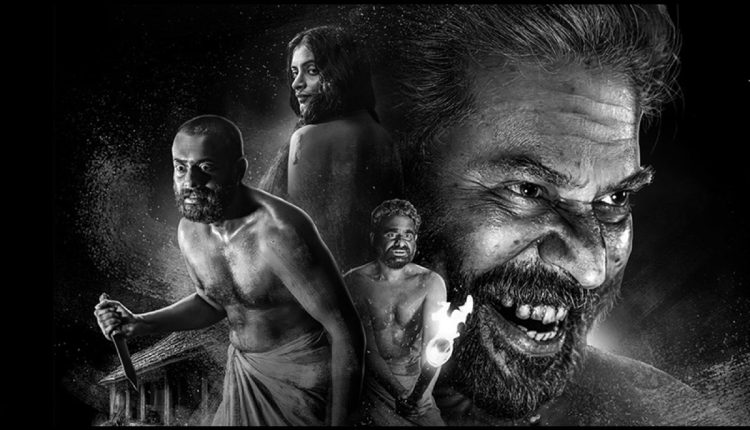A Horror That Creeps Beneath the Skin
Cinema is often measured in color, but sometimes, it’s in black and white that stories become eternal. Bramayugam, directed by Rahul Sadasivan, is a rare experiment in modern Indian cinema that dares to strip away the distractions and expose the raw fear that lies in silence, shadows, and human nature.
Set in an unspecified, hauntingly ancient era, Bramayugam doesn’t rely on jump scares or gore—it conjures dread from its stillness, its silences, and its symbolism.
And at the center of it all stands Mammootty, menacing and magnificent, in a role that redefines him yet again.
The Premise: A Strange House and a Stranger Host
The film begins with a folk singer (played by Arjun Ashokan) who stumbles upon an old manor deep within the woods. Desperate, hungry, and lost, he finds shelter in the eerie mansion of a mysterious old man—Kodumon Potti, played by Mammootty.
But this house doesn’t give shelter freely.
It feeds, it tests, and it traps.
And its master? He isn’t just a man. He’s a myth twisted into flesh, a nightmare dressed in tradition.
Mammootty as Kodumon Potti – A Masterclass in Minimalism
There are roles, and then there are incarnations. Mammootty doesn’t perform here—he haunts. His every glance, pause, and grin in Bramayugam carries a weight that creeps into your bones.
His portrayal of Potti is cold, calculating, ancient—yet hypnotically composed. He doesn’t need fangs or bloodshot eyes. He commands fear through presence alone.
It’s one of the most powerful and unsettling performances in his 50+ year career.
Black and White Cinematography – A Bold, Brilliant Stroke
Choosing to shoot Bramayugam in black and white wasn’t just an aesthetic decision—it was a narrative tool. It peels away distraction and immerses the viewer in texture, tone, and timelessness.
The use of shadows, fog, candlelight, and still frames transports us into a time that feels neither historical nor fictional—but disturbingly real.
Credit goes to Shehnad Jalal (cinematography) who creates a visual experience akin to reading an ancient cursed manuscript in visual form.
Folklore Meets Psychological Horror
At its core, Bramayugam is a Malayalam folktale gone rogue. It’s a descent into themes of:
-
Power and submission
-
Eternal punishment
-
Cultural decay
-
The fear of the unknown
-
The cyclical nature of evil
It invokes Kerala’s mythological past—Namboothiri rituals, oral traditions, forest spirits—but never explains too much. It trusts the audience to feel the truth rather than be told.
A Mind-Bending Narrative
The film unfolds like a parable, constantly blurring the lines between:
-
Reality and imagination
-
Guest and prisoner
-
Fear and fascination
-
Man and monster
This isn’t just a ghost story. It’s a mirror held up to human ambition, caste control, and the hunger for power.
The climax? Brutal, poetic, and open to interpretation. A filmmaker’s dream. A cinephile’s delight.
Sound Design & Music – Silence is Screaming
There is no loud music here. No dramatic orchestras. Only carefully crafted soundscapes—cracking wood, wind howling, low chants, and ominous silences.
Christo Xavier’s music enhances the unease. It whispers instead of shouting, letting our mind imagine horrors we don’t see. And those are always the most terrifying.
Bramayugam in Today’s Cinema – A Breath of Dark Air
In an era dominated by color-corrected commercial cinema, Bramayugam is a rebellion. It’s not just horror—it’s art. It demands your attention, your discomfort, and your thoughts long after the credits roll.
This is cinema for those who appreciate what hides between the lines, who seek stories that don’t offer comfort but questions.
Final Word: Bramayugam – A Beautifully Terrifying Folktale
Bramayugam doesn’t scream. It whispers in your ears.
It doesn’t show horror—it becomes horror.
It doesn’t rush you—it consumes you.
With Mammootty’s chilling performance, striking black-and-white frames, and deep-rooted cultural horror, Bramayugam stands as one of Malayalam cinema’s boldest and most unforgettable creations.
If cinema is a mirror to our fears, then Bramayugam is the cracked one—showing us the past, the present, and the darkness within.
By ARUN
For those who believe cinema is not always light—it can be shadow.


Comments are closed.